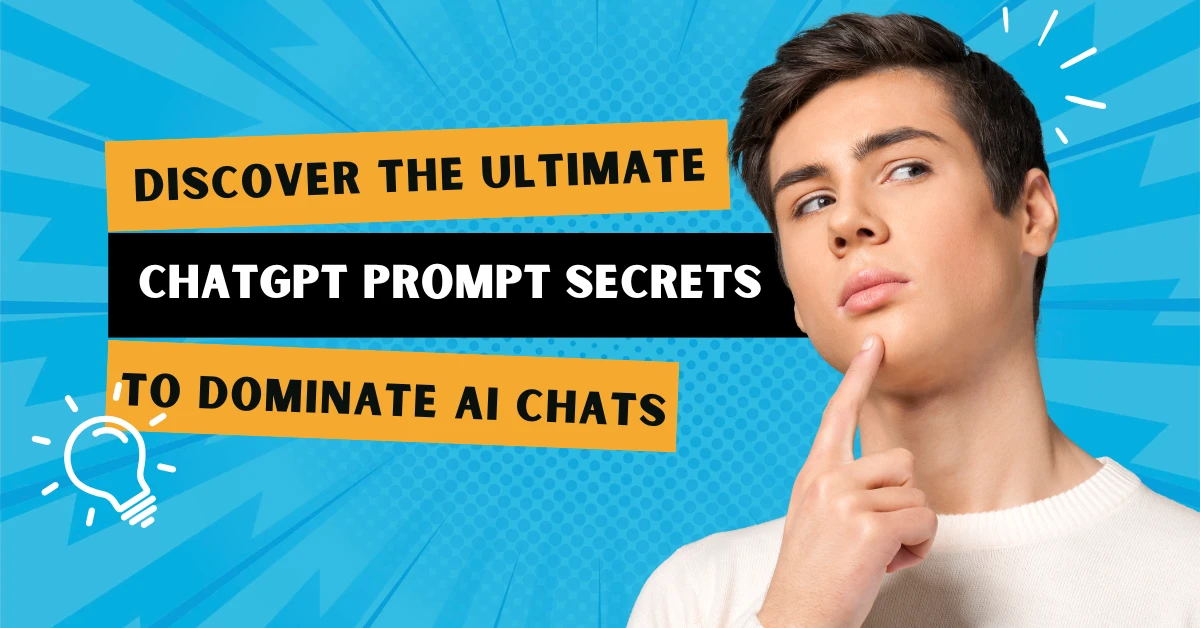Table of Contents
Ultimate ChatGPT Prompt Secrets to Dominate AI Chats: Ever stared at ChatGPT’s blinking cursor, knowing the difference between a mediocre response and digital gold lies entirely in what you type next? You’re not alone. 94% of ChatGPT users report getting wildly inconsistent results from their prompts.
Your frustration ends today. This guide unlocks the exact ChatGPT prompt secrets top AI whisperers use to consistently extract jaw-dropping content – the kind that makes colleagues ask “wait, how did you get it to do THAT?”
The truth is, mastering AI chat prompts isn’t about fancy terminology or coding knowledge. It’s about understanding the hidden psychology that makes these systems tick.
But here’s what most prompt guides get completely wrong about how ChatGPT actually processes your requests…

Understanding ChatGPT’s Foundation for Better Prompts
How ChatGPT’s AI Architecture Affects Response Quality
Ever wondered why ChatGPT sometimes gives you amazing answers and other times misses the mark completely? It all comes down to the underlying architecture. ChatGPT runs on a large language model (LLM) trained on billions of text examples. This foundation means it’s really good at pattern recognition but doesn’t actually “think” like you do.
When you craft prompts that align with how the model processes information, you’ll get dramatically better results. The model works by predicting the next most likely token (word or part of a word) based on what came before. This explains why giving clear context upfront leads to more accurate responses. ChatGPT Prompt Secrets to Dominate AI Chats.
The key insight? ChatGPT doesn’t have opinions or beliefs—it generates text based on statistical patterns. So when you ask it to “be creative” or “think outside the box,” you’re actually asking it to sample from less probable token combinations. Pretty cool, right?
The Importance of Context and Memory in Conversations
ChatGPT’s memory isn’t like yours. Without proper context management, your AI conversations will feel disjointed and frustrating.
Here’s what you need to know: ChatGPT only “remembers” what’s in the current conversation window. Once you start a new chat, all that context disappears. This limitation shapes how you should structure your prompts.
Want to maintain coherent, multi-turn conversations? You’ve got to explicitly reference important information from earlier exchanges. Think of it as constantly refreshing the AI’s short-term memory.
Many prompt experts use a technique called “context stacking” where they summarize previous exchanges before asking new questions. This keeps the conversation on track without hitting token limits. ChatGPT Prompt Secrets to Dominate AI Chats.
Remember: unlike humans, ChatGPT doesn’t naturally build a mental model of your needs over time. You need to be explicit about what matters.
Token Limitations and How They Shape Your Prompt Strategy
ChatGPT processes text in chunks called tokens—roughly 4 characters per token for English text. This matters because there’s a hard limit on how many tokens can fit in a conversation.
For GPT-4, you’re working with about 8,000 tokens (roughly 6,000 words) per conversation. This ceiling forces you to be strategic about your prompting approach.
When you hit that limit, earlier parts of your conversation get cut off, taking valuable context with them. This creates a practical constraint on how you structure complex requests.
Smart prompt strategies to work within token limits:
- Break complex tasks into smaller, sequential prompts
- Use precise language instead of verbose descriptions
- Ask for condensed responses when appropriate
- Remove unnecessary examples once the AI understands the pattern
- ChatGPT Prompt Secrets to Dominate AI Chats.
The most advanced prompt engineers treat token management as a core skill. They’re constantly balancing detail (which improves accuracy) against conciseness (which preserves context space).
Temperature Settings: When to Use High vs. Low Precision
The temperature setting is your secret weapon for controlling ChatGPT’s output style. Think of it as adjusting the AI’s “creativity knob.”
At low temperature settings (0.1-0.3), you get:
- More predictable, conservative responses
- Higher factual accuracy (usually)
- More deterministic results (ask twice, get similar answers)
- Perfect for coding, technical writing, and factual queries
- ChatGPT Prompt Secrets to Dominate AI Chats.
At high temperature settings (0.7-1.0), you get:
- More creative, varied responses
- Greater diversity in phrasing and structure
- Less predictable outcomes
- Ideal for brainstorming, creative writing, and generating alternatives
- ChatGPT Prompt Secrets to Dominate AI Chats.
Your choice should match your goal. Writing fiction? Crank up that temperature. Debugging code? Keep it cool and precise.
The smart approach is to vary your temperature based on the conversation phase. Start with higher temperatures when exploring ideas, then gradually lower it as you refine and implement specific solutions.

Mastering the Art of Clear Instructions
A. Command vs. request: How phrasing impacts ChatGPT’s responses
The way you phrase your prompts to ChatGPT dramatically changes what you get back. Think about the difference between these two approaches:
Request: “Could you please tell me about climate change?”
Command: “Explain climate change in 5 key points.”
See the difference? The command gets you a more focused, structured response. ChatGPT responds differently to authoritative directions versus polite inquiries.
When you need specific information quickly, direct commands work best:
- “List 7 ways to improve website conversion”
- “Define quantum computing in simple terms”
- “Compare Tesla and Ford’s market strategies”
- ChatGPT Prompt Secrets to Dominate AI Chats.
For more creative or open-ended responses, softer requests often work better:
- “Could you help me brainstorm marketing ideas?”
- “I’d love to hear your thoughts on this plot idea”
- ChatGPT Prompt Secrets to Dominate AI Chats.
B. Using delimiters to organize complex prompts
Ever sent a long, complicated prompt only to get a confused response? Delimiters are your secret weapon.
Delimiters are symbols that separate different parts of your prompt. They help ChatGPT understand exactly what’s what.
Common delimiters include:
Triple backticks ```like this```
Triple quotes """like this"""
Triple dashes ---like this---
Angle brackets <like this>
Here’s how to use them effectively:
Analyze this customer review:
"""
I ordered the blue sweater last week and while the color is beautiful,
the fabric is much thinner than expected. Shipping was fast though!
"""
Please identify:
<positive points>
<negative points>
<suggestions for improvement>
This clean structure helps ChatGPT deliver exactly what you want without mixing up instructions and content.
C. The power of explicit formatting instructions
Want your ChatGPT responses to look a certain way? Just ask!
ChatGPT doesn’t read your mind about how you want information presented. You need to spell it out.
Instead of vaguely asking for “information about dogs,” try:
“Create a table comparing:
- The three most popular dog breeds
- Their average lifespan
- Common health issues
- Temperament
- Exercise needs”
- ChatGPT Prompt Secrets to Dominate AI Chats.
You can request specific formats like:
- Bullet points for scannable information
- Numbered lists for sequential steps
- Tables for comparisons
- Bold text for key points
- Markdown formatting for structure
- ChatGPT Prompt Secrets to Dominate AI Chats.
The more precisely you describe your desired output format, the closer you’ll get to what you actually need.
D. When and how to use step-by-step directives
Some tasks demand a methodical approach. That’s when step-by-step directives shine.
Step-by-step instructions work best for:
- Complex processes that need breaking down
- Teaching someone a new skill
- Troubleshooting technical issues
- Creating detailed plans or strategies
- ChatGPT Prompt Secrets to Dominate AI Chats.
Try this format:
“Walk me through creating a Facebook ad campaign, including:
Step 1: [specific action]
Step 2: [specific action]
And so on…”
You can also ask ChatGPT to number steps automatically:
“Explain how to change a flat tire. Break it down into numbered steps with explanations for each.”
This approach forces a logical sequence and prevents ChatGPT from skipping crucial details.
E. Avoiding ambiguity with specific examples
Vague prompts = vague answers. It’s that simple.
The quickest way to improve your ChatGPT results is adding specific examples of what you want.
Instead of:
“Write me a good email.”
Try:
“Write a follow-up email to a potential client who requested a quote for web design services three days ago but hasn’t responded. The quote was for $3,500 for a 5-page website. Use a friendly but professional tone similar to this example:
‘Hi [Name], Just checking in regarding the proposal I sent over on Thursday…'”
Examples do three powerful things:
- Show the exact tone you want
- Demonstrate the level of detail needed
- Provide context that words alone can’t convey
- ChatGPT Prompt Secrets to Dominate AI Chats.
The more concrete your examples, the less room for misinterpretation.

Advanced Prompt Engineering Techniques
A. Role-prompting: Transforming ChatGPT into specific experts
Want to get expert-level responses? Role-prompting is your secret weapon. By assigning ChatGPT a specific role, you’re essentially telling it to think and respond from that perspective.
Try this: “You are an experienced mechanical engineer with 20 years in automotive design. Explain how regenerative braking works.”
The magic happens because you’ve created a context frame. ChatGPT will pull from its training related to that expertise and deliver more nuanced, technical, and accurate responses than if you just asked the question directly.
Some powerful roles to try:
- Financial advisor
- Literary critic
- Marketing strategist
- Medical researcher
- Legal consultant
- ChatGPT Prompt Secrets to Dominate AI Chats
But don’t stop at professional roles! You can also prompt for personality traits: “Answer as a patient, detail-oriented teacher who uses simple analogies.”
B. Chain-of-thought prompting for complex reasoning tasks
Ever notice how breaking down a problem step-by-step helps you solve it? That’s exactly what chain-of-thought prompting does for AI.
Instead of asking for a direct answer, ask ChatGPT to work through the problem in sequential steps. This works incredibly well for math problems, logical puzzles, and complex decisions. ChatGPT Prompt Secrets to Dominate AI Chats.
Try this approach: “Walk through how you’d calculate the compound interest on a $10,000 investment at 5% annual rate over 10 years. Show your thinking at each step.”
This technique dramatically improves accuracy because it forces the AI to:
- Break down the problem
- Apply specific formulas or reasoning
- Check work at each step
- Arrive at a conclusion logically
- ChatGPT Prompt Secrets to Dominate AI Chats
The best part? You can see exactly how ChatGPT reached its conclusion, making it easier to spot any errors in reasoning.
C. Few-shot learning to teach by example
Think about how you learn a new task – seeing examples helps, right? Few-shot learning works the same way with AI.
The technique is simple but powerful: provide 2-3 examples of what you want before asking for your actual request. ChatGPT will pick up on patterns in your examples and apply them to new situations. ChatGPT Prompt Secrets to Dominate AI Chats.
For instance:
Input: The movie was entertaining and well-acted.
Output: Positive sentiment
Input: The service was slow and the food was cold.
Output: Negative sentiment
Input: The hotel room was spacious but the view was disappointing.
Output: ?
By showing these examples, you’ve taught ChatGPT to classify sentiment without explicitly explaining the rules. This works for formatting preferences, writing styles, problem-solving approaches, and countless other tasks.
D. Zero-shot prompting when examples aren’t available
Sometimes you don’t have examples or the time to create them. That’s where zero-shot prompting comes in – asking ChatGPT to perform tasks without prior examples. ChatGPT Prompt Secrets to Dominate AI Chats.
The key to effective zero-shot prompting is specificity. You need to compensate for the lack of examples with clear instructions and constraints.
For best results:
- Define the format you want clearly
- Specify tone, length, and style
- Outline any constraints or requirements
- Ask for specific types of information
- ChatGPT Prompt Secrets to Dominate AI Chats
Example: “Create a product description for a waterproof smartwatch. Include bullet points for key features, a paragraph about battery life, and end with a call to action. Keep the tone enthusiastic but credible, and limit to 150 words.”
Zero-shot prompting works surprisingly well because ChatGPT was trained on diverse content. The more specific your instructions, the better it can meet your expectations without examples. ChatGPT Prompt Secrets to Dominate AI Chats.
Try combining zero-shot prompting with role-prompting for even more powerful results: “As an experienced copywriter, create a…”

Structuring Conversations for Maximum Value
How to maintain conversation history effectively
Ever notice how frustrating it is when someone forgets what you just talked about? The same applies to your ChatGPT conversations. To get the most value, you need to build on previous exchanges rather than starting from scratch each time.
Start by giving your chat sessions descriptive names. Instead of “New chat,” try “Website Homepage Content” or “Marketing Email Series.” This simple trick helps you quickly find and continue important conversations. ChatGPT Prompt Secrets to Dominate AI Chats.
When referencing previous parts of your chat, be specific: “As you mentioned earlier about the customer retention strategies…” This reinforces the context and keeps the AI on track.
For complex projects, try summarizing key points periodically:
“So far we’ve established:
- The target audience is millennials interested in sustainable fashion
- The brand voice should be casual but informative
- We need three email templates with different CTAs”
- ChatGPT Prompt Secrets to Dominate AI Chats
This creates checkpoints you can refer back to and ensures you’re both on the same page.
Pro tip: For longer conversations, copy important outputs into a separate document as a backup. ChatGPT’s memory isn’t perfect, and you don’t want to lose valuable insights if you accidentally refresh or the system hiccups.
Using system messages to set persistent parameters
Think of system messages as the behind-the-scenes director of your AI conversation. They’re powerful instructions that stick around, guiding how ChatGPT responds throughout your entire chat.
Unlike regular prompts that apply to a single response, system messages establish the rules of engagement for the whole conversation. They’re your secret weapon for consistent, targeted outputs. ChatGPT Prompt Secrets to Dominate AI Chats.
Here’s how to make them work harder for you:
Set the AI’s role with specificity: “You are a UX design consultant with 15 years of experience in e-commerce interfaces” creates a much more focused conversation than just asking for “design advice.”
Define output formats upfront: “Always structure your responses with Problem, Solution, and Implementation sections” ensures you get consistently organized answers.
Establish tone and style parameters: “Communicate like you’re explaining concepts to a smart 12-year-old” helps maintain the right level of simplicity throughout.
Avoid the common mistake of burying key instructions in lengthy system messages. Keep them clear and prioritized:
You are an expert content writer who:
1. Uses vivid examples
2. Avoids industry jargon
3. Includes actionable takeaways in every response
Remember to update your system message when shifting gears in a conversation. It’s like recalibrating your GPS when you change destinations.
The art of follow-up prompts and refinements
Getting that perfect AI response rarely happens on the first try. That’s where the magic of follow-up prompts comes in. They’re your steering wheel for navigating toward exactly what you need. ChatGPT Prompt Secrets to Dominate AI Chats.
The secret? Be incremental with your refinements. Instead of completely changing direction, build on what’s already been generated. Try phrases like:
“That’s a good start. Could you expand more on the third point about social media strategy?”
“I like the approach, but can you make it more suitable for beginners in the field?”
When something isn’t quite right, specify exactly what needs changing:
“The tone is too formal. Can you rewrite this using more conversational language like you’re explaining it to a friend?”
Think of your conversation as sculpting – first you get the rough shape, then you chisel away to reveal the masterpiece.
Create branching explorations by asking “what if” questions:
“What if we approached this problem from a sustainability angle instead?”
This technique helps you discover solutions you might not have considered initially.
Track your refinement journey mentally. Notice which follow-up questions yield the best improvements so you can replicate that pattern in future conversations.
Techniques for correcting and guiding ChatGPT mid-conversation
Sometimes your AI chat veers off course. No worries – you’ve got plenty of tools to get things back on track without starting over.
When you spot an error, address it directly: “Actually, the project timeline is June not July. Let’s continue with the correct deadline in mind.” This gentle correction keeps the conversation flowing while ensuring accuracy.
If ChatGPT misunderstands your intent, try this clarification formula:
“I think we’re miscommunicating. When I say [term], I’m referring to [your specific meaning], not [the misunderstanding]. Let’s continue with this understanding.”
When responses get too wordy or complex, simplify with: “That’s more detailed than I need right now. Can you give me a more concise version focusing just on the implementation steps?”
Use metaphors to redirect the conversation style: “Let’s switch gears – imagine you’re explaining this to a busy executive who only has 30 seconds of attention to give.”
If you need a completely fresh approach but want to maintain context, try: “I’d like to take a different angle on this topic. Let’s set aside what we’ve discussed about [previous approach] and instead explore [new direction].”
The most powerful correction technique is showing, not telling. Provide a brief example of the format, style, or approach you want: “I’m looking for something more like this: [example].”

Specialized Prompt Strategies by Use Case
A. Content creation prompts that generate publish-ready material
Want to skip the endless revisions and get straight to publishing? It’s all about crafting prompts that do the heavy lifting for you.
Try this formula: “Create a [content type] about [topic] that includes [specific elements] and speaks to [target audience] with a [tone] voice.”
For example:
Create a product description for a smart water bottle that includes features, benefits, and technical specifications, speaking to health-conscious professionals with an enthusiastic yet professional voice.
You’ll get better results by adding context constraints:
- Word count limits
- Formatting requirements
- SEO considerations
- Call-to-action specifications
- ChatGPT Prompt Secrets to Dominate AI Chats
What separates good prompts from great ones? Specificity. Rather than asking for “a blog post about dogs,” request “a 1,000-word blog post about training rescue dogs with separation anxiety, including actionable tips, personal anecdotes, and scientific backing.” ChatGPT Prompt Secrets to Dominate AI Chats.
Think of your prompt as a creative brief. The more detailed your instructions, the closer the first draft will be to your final vision.
B. Problem-solving prompts that yield actionable solutions
Stuck with a thorny problem? ChatGPT can help—if you frame your prompt correctly.
Start by defining the problem clearly with this structure:
I'm facing [specific issue]. The context is [relevant background]. My goal is [desired outcome]. The constraints are [limitations]. What actionable steps can I take to solve this problem?
This works because you’re giving ChatGPT the full picture before asking for solutions.
For complex problems, break them down:
- First, ask ChatGPT to analyze the problem from multiple angles
- Then request specific solution approaches
- Finally, ask for implementation steps for your favorite approach
- ChatGPT Prompt Secrets to Dominate AI Chats
Pro tip: Add “Consider approaches I might not have thought of” to push beyond obvious solutions.
If you get generic advice, don’t settle! Follow up with “That’s helpful, but can you make these suggestions more specific to my situation with [additional context]?”
The magic happens when you treat ChatGPT as a collaborative thinking partner rather than just an answer machine.
C. Creative writing prompts that unlock ChatGPT’s imagination
Hitting a creative wall? The right prompt can transform ChatGPT into your personal muse.
For fiction writing, try this template:
Write a [genre] story about [character] who [interesting situation] in a world where [unique element]. Use [writing style] and include themes of [themes].
This gives ChatGPT enough creative direction without boxing it in.
When you’re looking for fresh ideas, ask ChatGPT to generate multiple concepts:
Generate 5 unique story premises involving [elements you want] but with unexpected twists.
You can also use ChatGPT to develop existing ideas. Try:
- “Expand this character description with deeper motivations and flaws…”
- “Take this plot outline and suggest three different ways this scene could play out…”
- “Rewrite this dialogue to increase tension between the characters…”
- ChatGPT Prompt Secrets to Dominate AI Chats
The best results come when you iterate. Start with a creative seed, see what ChatGPT offers, then build on the most interesting elements with follow-up prompts. ChatGPT Prompt Secrets to Dominate AI Chats.
Remember: Creative prompts work best when they combine familiar elements in unfamiliar ways.
D. Data analysis prompts for extracting meaningful insights
Raw data is just numbers until you extract the story hiding inside. ChatGPT can help you find those narratives if you structure your prompts correctly.
For basic analysis, this template works wonders:
I have data showing [describe your dataset]. Help me analyze this to understand [specific question]. Focus on [particular aspects] and highlight any unexpected patterns.
You’ll get more valuable insights by being specific about your analysis goals:
- Trend identification (“Show me how X has changed over time”)
- Correlation spotting (“Explore relationships between variables A and B”)
- Anomaly detection (“Identify outliers and explain possible causes”)
- Comparative analysis (“Compare performance across these segments”)
- ChatGPT Prompt Secrets to Dominate AI Chats
When working with actual numbers, format your data clearly:
Analyze this sales data by region:
Region A: $145K (Q1), $152K (Q2), $138K (Q3), $162K (Q4)
Region B: $98K (Q1), $112K (Q2), $132K (Q3), $121K (Q4)[etc.]
For complex analyses, ask ChatGPT to suggest visualization approaches or statistical methods that would best represent your findings.
The key difference between basic and powerful data prompts? Asking not just “what” the data shows but “why” it matters and “how” you should act on it.

Ethical Prompt Engineering and Limitations
Working within content policy boundaries
Look, AI is amazing. But it’s not a free-for-all. You need to understand the guardrails that platforms like OpenAI have set up. These aren’t just arbitrary rules – they’re designed to prevent harmful content generation.
When crafting your prompts, familiarize yourself with these boundaries. For example, OpenAI prohibits generating content that promotes illegal activities, creates malicious code, or spreads misinformation. Your clever workarounds to “jailbreak” these protections might seem fun, but they undermine the safety measures put in place for good reasons. ChatGPT Prompt Secrets to Dominate AI Chats.
Think of content policies as traffic laws – they’re there so everyone can use the road safely, not to spoil your fun.
Handling sensitive topics responsibly
Got a tricky subject? Approach it with care. When you need AI assistance with sensitive topics like mental health, political divisions, or personal finance, frame your prompts thoughtfully.
Always ask yourself: “What’s my actual goal here?” If you’re researching a difficult topic, be direct about your educational purpose. Something like: “I’m writing a research paper on addiction recovery methods. Can you provide an overview of evidence-based approaches?” ChatGPT Prompt Secrets to Dominate AI Chats.
Avoid prompts that might generate potentially harmful advice or one-sided perspectives on divisive issues. The goal isn’t to avoid important topics – it’s to address them responsibly.
Recognizing when AI is not the right tool
AI is powerful but not perfect for everything. Some situations where you should put the AI down and seek human expertise:
- Medical diagnoses or treatment recommendations
- Legal advice for specific situations
- Mental health crises
- Financial decisions with significant consequences
- Situations requiring cultural nuance or lived experience
- ChatGPT Prompt Secrets to Dominate AI Chats
The pattern? High-stakes decisions need human judgment. AI tools can complement human expertise but shouldn’t replace it entirely.
Remember that moment when you asked ChatGPT something and got a confident but completely wrong answer? That’s exactly why verification matters.
Maintaining human oversight and validation
Your relationship with AI should be collaborative, not dependent. You’re still responsible for the output you use or share.
Always fact-check important information. AI systems can “hallucinate” – confidently stating incorrect information as fact. This happens because they’re predicting what sounds right based on patterns, not because they understand truth. ChatGPT Prompt Secrets to Dominate AI Chats.
Develop a healthy skepticism. When ChatGPT gives you a statistic, source, or scientific claim, verify it independently. Cross-reference with reliable sources before using the information in important contexts.
Your expertise and critical thinking are the final filters. Trust your judgment when something doesn’t sound right – chances are, you’re onto something.

Testing and Optimizing Your Prompts
A/B Testing Methodologies for Prompt Refinement
Ever wonder why some of your ChatGPT prompts hit the mark while others fall flat? A/B testing is your secret weapon.
Start by creating two versions of your prompt (A and B) with just one variable changed. Maybe version A uses a direct command while version B frames it as a question. Run both prompts several times and compare the outputs. ChatGPT Prompt Secrets to Dominate AI Chats.
Want to go deeper? Try multivariate testing where you experiment with several elements:
- Length (short vs. detailed prompts)
- Tone (formal vs. casual)
- Structure (bulleted vs. paragraph format)
- Context (with vs. without background information)
- ChatGPT Prompt Secrets to Dominate AI Chats
The key is isolation – change just one thing at a time so you know exactly what’s working. Keep a simple tracking sheet:
| Prompt Version | Variable Changed | Quality Score (1-10) | Response Time | Word Count |
|---|---|---|---|---|
| A | Direct command | 7 | Fast | 150 |
| B | Question format | 9 | Medium | 220 |
Key Metrics to Evaluate Prompt Effectiveness
Not all ChatGPT responses are created equal. To truly optimize your prompts, you need clear metrics.
Track these five core measurements:
- Relevance Score – How directly does the response address your intended query? Rate it 1-10.
- Completion Rate – Did the AI fully answer everything you asked, or did it miss parts?
- Creativity Spectrum – For creative tasks, how innovative was the output? For factual tasks, how accurate?
- Response Length – Too short might lack depth, too long might indicate rambling.
- Consistency – Run the same prompt 3-5 times. Do you get similar quality responses?
- ChatGPT Prompt Secrets to Dominate AI Chats
Create a simple scoring system that weights these factors based on your specific goals. A research prompt might prioritize accuracy, while a creative writing prompt might value originality more.
Creating a Personal Prompt Library for Reuse
You’ve crafted the perfect prompt that delivers amazing results. Don’t let it disappear into the void!
Build your personal prompt library – it’s a game-changer for efficiency. Here’s how:
Start with categories that match your common use cases:
- Writing assistance
- Research queries
- Creative ideation
- Code generation
- Summarization tools
- ChatGPT Prompt Secrets to Dominate AI Chats
For each winning prompt, document:
- The full prompt text
- What it does exceptionally well
- Any special formatting or instruction patterns
- Variations that work for different situations
- ChatGPT Prompt Secrets to Dominate AI Chats
Use a naming convention that makes sense to you: “Blog_Outline_Generator_V2” is much better than “Prompt123.”
The magic happens when you begin mixing and matching elements from successful prompts to create new ones. Your library becomes a living laboratory of what works. ChatGPT Prompt Secrets to Dominate AI Chats.
Tools and Platforms for Prompt Management
Managing your growing collection of perfect prompts shouldn’t be a headache. These tools will transform how you organize and deploy your AI conversations:
Lightweight Options:
- Notion templates with toggle features to organize prompts by category
- Google Docs with a table of contents for quick navigation
- Obsidian for connecting related prompts with backlinks
- ChatGPT Prompt Secrets to Dominate AI Chats
Dedicated Prompt Management Platforms:
- PromptBase: Store, categorize, and even monetize your best prompts
- FlowGPT: Community-focused platform to share and discover prompts
- Dust.tt: Build prompt workflows and track performance
- ChatGPT Prompt Secrets to Dominate AI Chats
Browser Extensions:
- ChatGPT Prompt Genius: Save prompts directly within the ChatGPT interface
- Promptheus: Quick access to your prompt library while chatting
- ChatGPT Prompt Secrets to Dominate AI Chats
The real productivity boost comes from tools that let you analyze which prompts perform best over time. Look for features that track success metrics and allow for quick iteration.
Set aside 15 minutes weekly to curate your library – delete what doesn’t work, refine what shows promise, and organize for quick access when inspiration strikes.

Conclusion
Unlocking ChatGPT’s full potential requires more than basic prompting skills—it demands a strategic approach that combines clear instructions, advanced techniques, and ethical considerations. By understanding ChatGPT’s foundation, structuring your conversations effectively, and tailoring your prompts to specific use cases, you’ve now gained the knowledge to transform ordinary AI interactions into extraordinary results. ChatGPT Prompt Secrets to Dominate AI Chats.
Remember, prompt engineering is both an art and a science that improves with practice. Take time to test and refine your prompts, pay attention to how you frame your instructions, and always consider the ethical implications of your requests. Whether you’re using ChatGPT for creative writing, business applications, or personal assistance, these prompt secrets will help you navigate AI conversations with confidence and achieve outcomes you never thought possible. Start implementing these techniques today, and watch as your ChatGPT interactions reach new heights of efficiency and effectiveness.

Frequently Asked Questions (FAQs) About ChatGPT Prompt Secrets to Dominate AI Chats
What exactly is prompt engineering, and why does it matter?
Prompt engineering is the practice of carefully crafting the text you give ChatGPT so that it produces more accurate, useful, or creative outputs. It matters because small changes in wording, structure, or context can dramatically improve response quality. ChatGPT Prompt Secrets to Dominate AI Chats.
How do I ensure ChatGPT “remembers” important details across turns?
Use context stacking: begin each new prompt by briefly summarizing prior key points (or copy-paste essential context). This constantly refreshes the AI’s short-term memory within the token window. ChatGPT Prompt Secrets to Dominate AI Chats.
What are token limits, and how should I adapt my prompts?
Each chunk of text is broken into tokens (≈4 characters each). GPT-4’s chats cap at ~8,000 tokens (≈6,000 words). To stay under the limit, break big tasks into smaller prompts, remove redundancy, and ask for concise summaries when possible. ChatGPT Prompt Secrets to Dominate AI Chats.
How can delimiters help organize complex prompts?
Wrapping different sections of your prompt in triple backticks (…), quotes, or custom markers (like <analysis>/<deliverables>) tells ChatGPT exactly which part is instruction and which is content, avoiding confusion in multi-part queries. ChatGPT Prompt Secrets to Dominate AI Chats.
What is role-prompting, and when should I use it?
Role-prompting assigns ChatGPT a persona or expertise (e.g., “You are a financial advisor”). This frames its responses to be more nuanced and aligned with that domain—useful when you need specialized, context-aware answers. ChatGPT Prompt Secrets to Dominate AI Chats.
